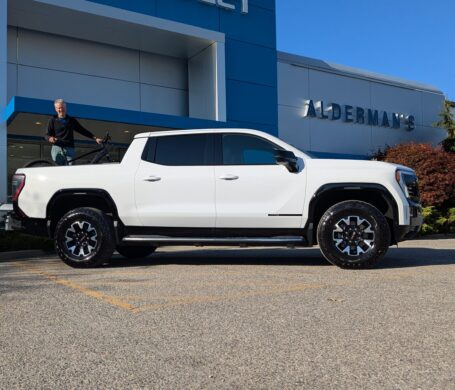We just took another big step in our path to electrifying as much as we can – purchasing a Sierra AT4 Extended Range truck to replace our aging Sierra 2500 gas truck. One of our partners figured it was only right to use the opportunity of picking up the new electric truck as an excuse to take a very, very long electric bike ride. Josh borrowed a coworker’s Specialized Electric Mountain bike and spent the day biking the seventy miles from Montpelier to Rutland, VT where the truck was waiting. Along the way, he stopped at the Pittsfield, VT Original General Store to refuel both bike and human – the bike was down to 26% of its 50 mile range with the climb up and over Killington ahead. Josh had a sandwich and the bike sipped its way back to 42% from the outlet on the porch, giving them both the energy to get into turbo mode and make it up over the hill and down to Rutland. Wattage well spent. They cruised back in comfort – heated and ventilated seats for Josh, 110V in the back for the Stallion.
Especially in a rural state like Vermont, driving to and from the jobsite represents a huge hidden carbon cost. It’s been relatively straightforward for environmentally conscious construction companies to electrify their shops, and to design and build energy efficient homes. More and more, the products we use to build those houses have low embodied carbon, at least relative to 20 years ago. But commuting to jobsites that are inevitably an hour away in such a rural area burns through a lot of gas that is often overlooked. While very worthy pursuits, building Net Zero and Passive House Certified buildings focuses on the “Operational Energy Consumption” of the house, and doesn’t count the significant carbon cost of actually building it, including the commuting costs. We are excited to see what this first step towards electrifying our commute looks like. Onward …..


